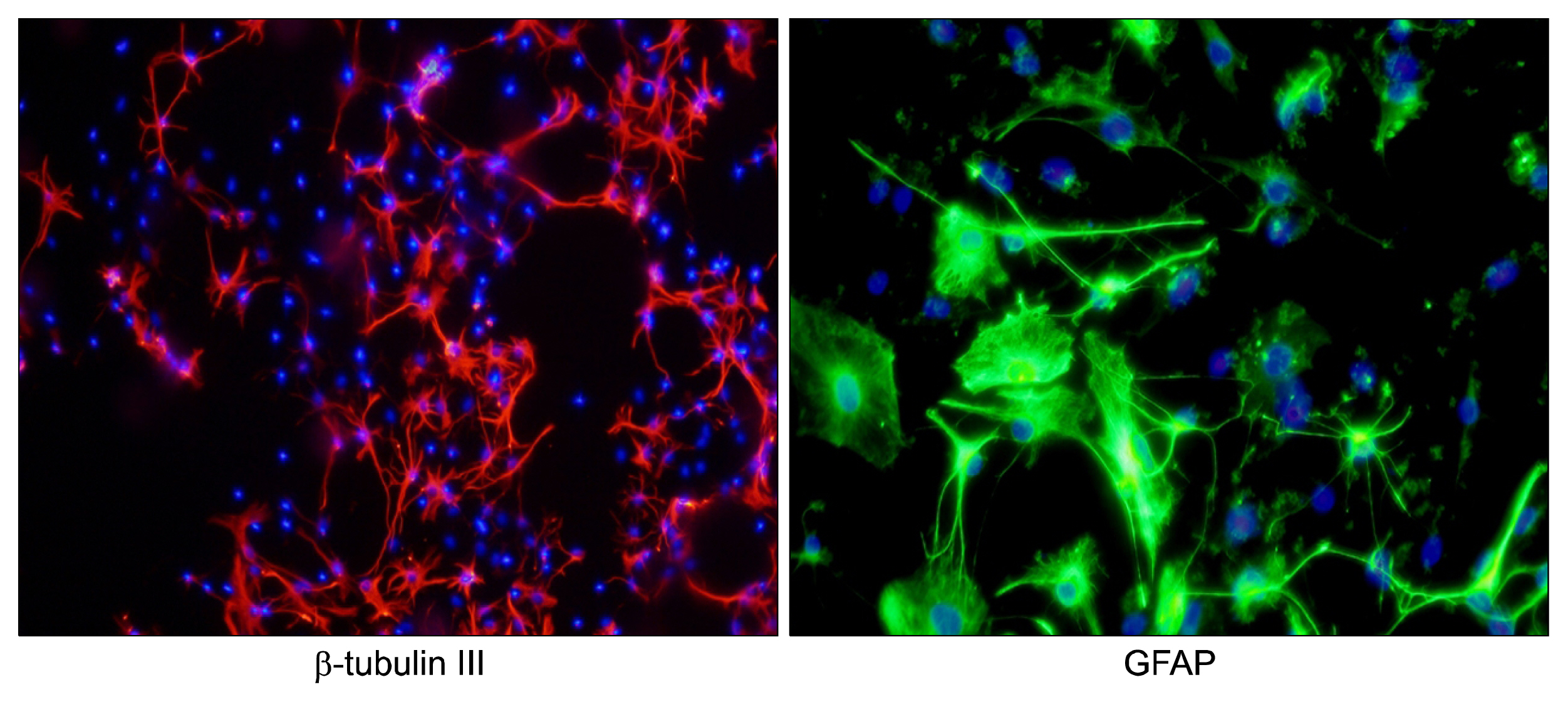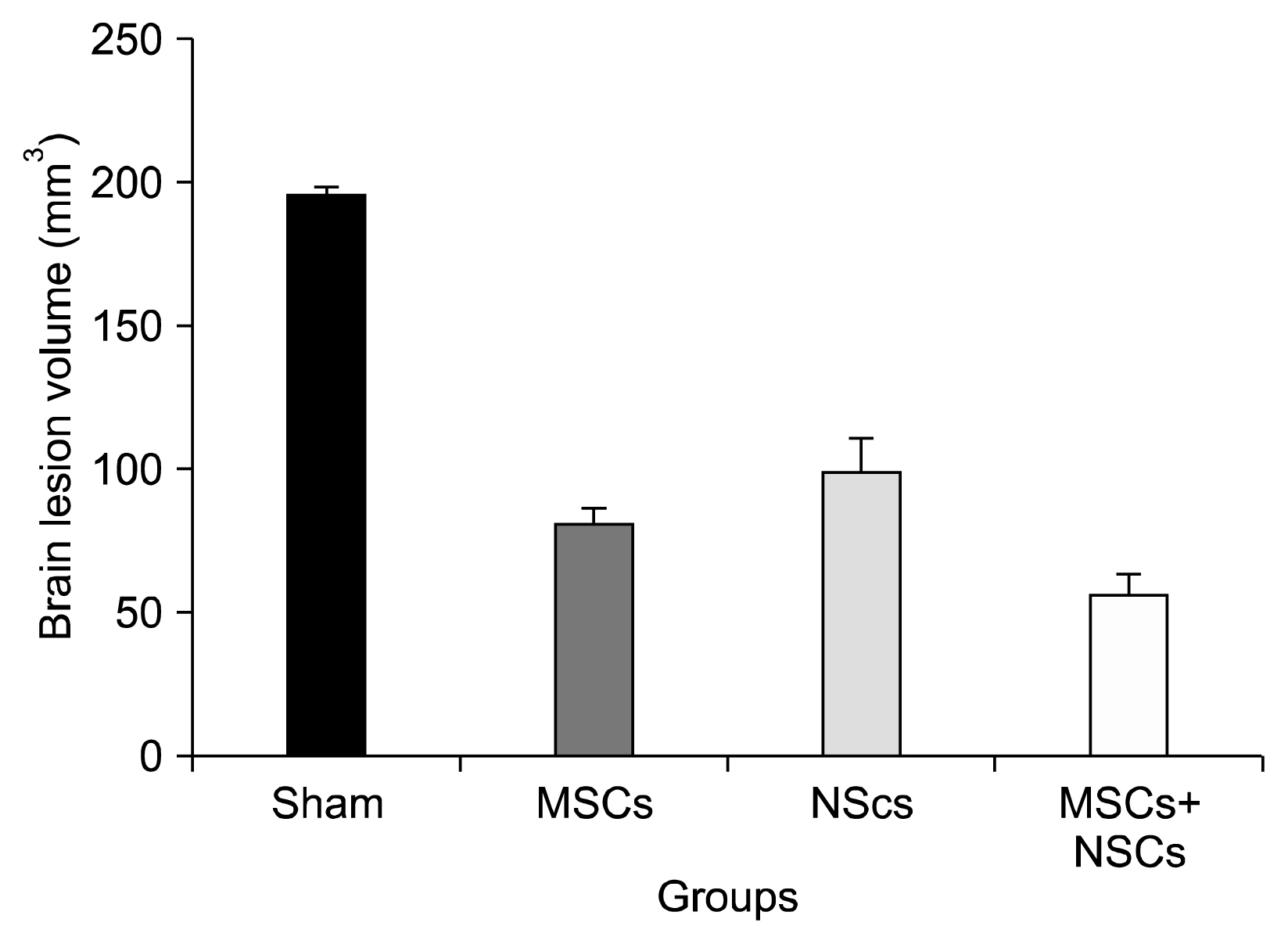Int J Stem Cells.
2015 May;8(1):99-105. 10.15283/ijsc.2015.8.1.99.
Combination Cell Therapy with Mesenchymal Stem Cells and Neural Stem Cells for Brain Stroke in Rats
- Affiliations
-
- 1Student Research Committee, Shiraz University of Medical Sciences, Shiraz, Iran. hoseini2010m@gmail.com
- 2Cell and Molecular Student Research Group, Medical School, Shiraz University of Medical Sciences, Shiraz, Iran.
- 3Stem Cell laboratory, Department of Anatomy, Shiraz University of Medical Sciences, Shiraz, Iran.
- KMID: 2380803
- DOI: http://doi.org/10.15283/ijsc.2015.8.1.99
Abstract
OBJECTIVES
Brain stroke is the second most important events that lead to disability and morbidity these days. Although, stroke is important, there is no treatment for curing this problem. Nowadays, cell therapy has opened a new window for treating central nervous system disease. In some previous studies the Mesenchymal stem cells and neural stem cells. In this study, we have designed an experiment to assess the combination cell therapy (Mesenchymal and Neural stem cells) effects on brain stroke. METHOD AND MATERIALS: The Mesenchymal stem cells were isolated from adult rat bone marrow and the neural stem cells were isolated from ganglion eminence of rat embryo 14 days. The Mesenchymal stem cells were injected 1 day after middle cerebral artery occlusion (MCAO) and the neural stem cells transplanted 7 day after MCAO. After 28 days, the neurological outcomes and brain lesion volumes were evaluated. Also, the activity of Caspase 3 was assessed in different groups. RESULT: The group which received combination cell therapy had better neurological examination and less brain lesion. Also the combination cell therapy group had the least Caspase 3 activity among the groups.
CONCLUSIONS
The combination cell therapy is more effective than Mesenchymal stem cell therapy and neural stem cell therapy separately in treating the brain stroke in rats.
MeSH Terms
Figure
Reference
-
References
1. Murray CJ, Lopez AD. Mortality by cause for eight regions of the world: Global Burden of Disease Study. Lancet. 1997; 349:1269–1276. PMID: 9142060.
Article2. Donnan GA, Fisher M, Macleod M, Davis SM. Stroke. Lancet. 2008; 371:1612–1623. PMID: 18468545.
Article3. Murray CJ, Lopez AD. Global mortality, disability, and the contribution of risk factors: Global Burden of Disease Study. Lancet. 1997; 349:1436–1442. PMID: 9164317.
Article4. Barber PA, Auer RN, Buchan AM, Sutherland GR. Understanding and managing ischemic stroke. Can J Physiol Pharmacol. 2001; 79:283–296. PMID: 11294605.
Article5. Dirnagl U, Iadecola C, Moskowitz MA. Pathobiology of ischaemic stroke: an integrated view. Trends Neurosci. 1999; 22:391–397. PMID: 10441299.
Article6. Lo EH, Dalkara T, Moskowitz MA. Mechanisms, challenges and opportunities in stroke. Nat Rev Neurosci. 2003; 4:399–415. PMID: 12728267.
Article7. Lakhan SE, Kirchgessner A, Hofer M. Inflammatory mechanisms in ischemic stroke: therapeutic approaches. J Transl Med. 2009; 7:97. PMID: 19919699. PMCID: 2780998.
Article8. Dirnagl U, Iadecola C, Moskowitz MA. Pathobiology of ischaemic stroke: an integrated view. Trends Neurosci. 1999; 22:391–397. PMID: 10441299.
Article9. Dharmasaroja P. Bone marrow-derived mesenchymal stem cells for the treatment of ischemic stroke. Journal of Clinical Neuroscience. 2009; 16:12–20. DOI: 10.1016/j.jocn.2008.05.006.
Article10. Chung TN, Kim JH, Choi BY, Chung SP, Kwon SW, Suh SW. Adipose-derived mesenchymal stem cells reduce neuronal death after transient global cerebral ischemia through prevention of blood-brain barrier disruption and endothelial damage. Stem Cells Transl Med. 2015; 4:178–185.
Article11. Paradisi M, Alviano F, Pirondi S, Lanzoni G, Fernandez M, Lizzo G, Giardino L, Giuliani A, Costa R, Marchionni C, Bonsi L, Calza L. Human mesenchymal stem cells produce bioactive neurotrophic factors: source, individual variability and differentiation issues. Int J Immunopathol Pharmacol. 2014; 27:391–402. PMID: 25280030.
Article12. Liu J, Wang Y, Wu Y, Ni B, Liang Z. Sodium butyrate promotes the differentiation of rat bone marrow mesenchymal stem cells to smooth muscle cells through histone acetylation. PLoS One. 2014; 9:e116183. DOI: 10.1371/journal.pone.0116183. PMID: 25548915. PMCID: 4280132.
Article13. Hosseini SM, Talaei-Khozani T, Sani M, Owrangi B. Differentiation of human breast-milk stem cells to neural stem cells and neurons. Neurol Res Int. 2014; 2014:807896. PMID: 25506428. PMCID: 4260437.
Article14. Wang L, Jiang F, Li Q, He X, Ma J. Mild hypothermia combined with neural stem cell transplantation for hypoxic-ischemic encephalopathy: neuroprotective effects of combined therapy. Neural Regen Res. 2014; 9:1745–1752. PMID: 25422635. PMCID: 4238162.
Article15. Koizumi J, Yoshida Y, Nakazawa T, Ooneda G. Experimental studies of ischemic brain edema: 1. A new experimental model of cerebral embolism in rats in which recirculation can be introduced in the ischemic area. Jpn J Stroke. 1986; 8:1–8.16. Longa EZ, Weinstein PR, Carlson S, Cummins R. Reversible middle cerebral artery occlusion without craniectomy in rats. Stroke. 1989; 20:84–91. DOI: 10.1161/01.STR.20.1.84. PMID: 2643202.
Article17. Nasir GA, Mohsin S, Khan M, Shams S, Ali G, Khan SN, Riazuddin S. Mesenchymal stem cells and Interleukin-6 attenuate liver fibrosis in mice. J Transl Med. 2013; 11:78. PMID: 23531302. PMCID: 3636128.
Article18. Cheng Q, Zhang Z, Zhang S, Yang H, Zhang X, Pan J, Weng L, Sha D, Zhu M, Hu X, Xu Y. Human umbilical cord mesenchymal stem cells protect against ischemic brain injury in mouse by regulating peripheral immunoinflammation. Brain Res. 2015; 1594:293–304.
Article19. Mert T, Kurt AH, Arslan M, Çelik A, Tugtag B, Akkurt A. Anti-inflammatory and Anti-nociceptive Actions of Systemically or Locally Treated Adipose-Derived Mesenchymal Stem Cells in Experimental Inflammatory Model. Inflammation. 2015; Epub ahead of print. DOI: 10.1007/s10753-014-0101-1. PMID: 25563206.
Article20. Gu N, Rao C, Tian Y, Di Z, Liu Z, Chang M, Lei H. Anti-inflammatory and antiapoptotic effects of mesenchymal stem cells transplantation in rat brain with cerebral ischemia. J Stroke Cerebrovasc Dis. 2014; 23:2598–2606. PMID: 25280822.
Article21. Calió ML, Marinho DS, Ko GM, Ribeiro RR, Carbonel AF, Oyama LM, Ormanji M, Guirao TP, Calió PL, Reis LA, de Simões MJ, Lisbôa-Nascimento T, Ferreira AT, Bertoncini CR. Transplantation of bone marrow mesenchymal stem cells decreases oxidative stress, apoptosis, and hippocampal damage in brain of a spontaneous stroke model. Free Radic Biol Med. 2014; 70:141–154. DOI: 10.1016/j.freeradbiomed.2014.01.024. PMID: 24525001.
Article22. Mead B, Logan A, Berry M, Leadbeater W, Scheven BA. Paracrine-mediated neuroprotection and neuritogenesis of axotomised retinal ganglion cells by human dental pulp stem cells: comparison with human bone marrow and adipose-derived mesenchymal stem cells. PLoS One. 2014; 9:e109305. DOI: 10.1371/journal.pone.0109305. PMID: 25290916. PMCID: 4188599.
Article23. Song J, Cho KJ, Cheon SY, Kim SH, Park KA, Lee WT, Lee JE. Apoptosis signal-regulating kinase 1 (ASK1) is linked to neural stem cell differentiation after ischemic brain injury. Exp Mol Med. 2013; 45:e69. DOI: 10.1038/emm.2013.134. PMID: 24357833. PMCID: 3880461.
Article24. Tang Y, Wang J, Lin X, Wang L, Shao B, Jin K, Wang Y, Yang GY. Neural stem cell protects aged rat brain from ischemia-reperfusion injury through neurogenesis and angiogenesis. J Cereb Blood Flow Metab. 2014; 34:1138–1147. DOI: 10.1038/jcbfm.2014.61. PMID: 24714034. PMCID: 4083376.
Article25. Kim JH, Lee J. Induced neural stem cells protect neuronal cells against apoptosis. Med Sci Monit. 2014; 20:2759–2766. DOI: 10.12659/MSM.891343.
Article26. Kim HS, Choi SM, Yang W, Kim DS, Lee DR, Cho SR, Kim DW. PSA-NCAM(+) neural precursor cells from human embryonic stem cells promote neural tissue integrity and behavioral performance in a rat stroke model. Stem Cell Rev. 2014; 10:761–771. DOI: 10.1007/s12015-014-9535-y. PMID: 24974101.
Article27. Kim JH, Sun W, Han DW, Moon HJ, Lee J. iNSC suppress macrophage-induced inflammation by repressing COX-2. In Vitro Cell Dev Biol Anim. 2015; 51:157–164. DOI: 10.1007/s11626-014-9816-4.
Article
- Full Text Links
- Actions
-
Cited
- CITED
-
- Close
- Share
- Similar articles
-
- Clinical Trials of Adult Stem Cell Therapy in Patients with Ischemic Stroke
- A Novel Cell Therapy Method for Recovering after Brain Stroke in Rats
- Neural Stem Cells and Ischemic Brain
- Adult Stem Cell Therapy for Stroke: Challenges and Progress
- Mesenchymal stem cells promote proliferation of endogenous neural stem cells and survival of newborn cells in a rat stroke model








